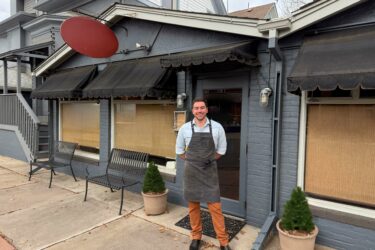Even the best home bakers and professionals have found that their favorite recipes don’t quite turn out the same here in Colorado. There’s a lot of careful chemistry involved in achieving the perfect pastry, especially at high altitudes.
“The low air pressure at higher altitudes brings the boiling point of water down, causing your cakes and quick breads to dry out more quickly if you follow the original recipe,” Ann Marie Trent, kitchen manager at Cake Crumbs Bakery & Café, explains. “This also interferes with the way the baked goods handle the sugar content and any chemical leavening agents, leaving your cookies and cakes dull and flat. While there is a set of ‘guidelines’ to follow, there will also be quite a bit of trial and error.”
If you’re an allergy-friendly kitchen, Nicole Kurland of Allergy Free Baking Company says that as long as your gluten-free blend contains a binder in it such as xanthan gum or guar gum, you can directly replace regular flour with a gluten-free blend.
Most recipes are written for lower altitudes, says Mark Hill, owner of Meraki Custom Cakes. Local bakers have fiddled with the formula and found these adjustments helpful.
Tips:
Cake, muffins, cornbread, and quick breads
- Add extra liquid: For every cup of liquid in the original recipe, there should be three additional tablespoons added. Try an extra egg yolk, heavy cream, full fat yogurt, other dairy, water, or oil.
- Increase the temperature: Try this for cakes and cupcakes. It should help the structure set quicker. A good starting point is 25 degrees higher.
- Decrease baking time: Offset higher temperatures with lower bake times to prevent over baking. Start with 10 to 15 minutes, but keep an eye on it!
- Decrease sugar: Too much weakens the structure of a baked good. Start by reducing the amount by two tablespoons for every cup in the original recipe.
- Decrease (chemical) leavening: If using baking powder, decrease by ¼ to ½ teaspoon in the original recipe. If using baking soda, decrease it by just a pinch.
Cookies
- Add extra liquid: For every cup of liquid in the original recipe, there should be three additional tablespoons added. Try an extra egg yolk, heavy cream, full fat yogurt, other dairy, water, or oil.
- Decrease sugar: Too much weakens the structure of a baked good. Start by reducing the amount by two tablespoons for every cup in the original recipe.
- Decrease (chemical) leavening: If using baking powder, decrease by ¼ to ½ teaspoon in the original recipe. If using baking soda, decrease it by just a pinch.
- Chill the dough: Try rolling the dough into balls or a log and chill in the refrigerator for a few hours before baking. This can slow the dough’s spread in the oven and create a pillow in the middle of your cookie.
Breads
- Proof your proof time: When allowing bread dough to rise, keep an eye on it. Your proof time may decrease.
READ MORE: High Altitude Recipes for 4 Family Favorites





